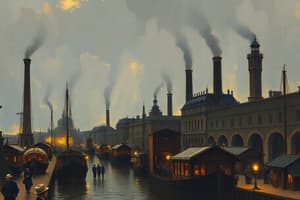Podcast
Questions and Answers
What was a key characteristic of the First Industrial Revolution?
What was a key characteristic of the First Industrial Revolution?
- Promotion of artisanal trades
- Dominance of agriculture over industry
- Emergence of the steam engine and factory systems (correct)
- Use of electricity as an energy source
The population of England decreased from 1701 to 1851.
The population of England decreased from 1701 to 1851.
False (B)
Which region in England is primarily associated with the beginnings of the Industrial Revolution?
Which region in England is primarily associated with the beginnings of the Industrial Revolution?
Lancashire
The average annual population growth rate during the demographic revolution ranged between _____ and _____ percent.
The average annual population growth rate during the demographic revolution ranged between _____ and _____ percent.
Match the following factors with their impact on the population growth during the Industrial Revolution:
Match the following factors with their impact on the population growth during the Industrial Revolution:
What factor contributed to the lower mortality rates observed during the Industrial Revolution?
What factor contributed to the lower mortality rates observed during the Industrial Revolution?
The Second Industrial Revolution introduced coal as the primary energy source.
The Second Industrial Revolution introduced coal as the primary energy source.
What demographic changes were noted in England from 1740 to 1800?
What demographic changes were noted in England from 1740 to 1800?
The _____ served as a driving force for the innovations of the Industrial Revolution, especially in the textile industry.
The _____ served as a driving force for the innovations of the Industrial Revolution, especially in the textile industry.
What was a major factor in the success of British industrialization during the Industrial Revolution?
What was a major factor in the success of British industrialization during the Industrial Revolution?
Flashcards
Industrial Revolution Origins
Industrial Revolution Origins
A widespread transformation of economies and societies, starting in the UK and spreading globally, driven by changes in demographics, agriculture, manufacturing, banking, commerce, and transportation.
Old Regime
Old Regime
Pre-industrial societies characterized by subsistence agriculture and limited industrial development.
Population Growth
Population Growth
Significant increase in the number of people, a key factor in the Industrial Revolution, driven by lower mortality and high birth rates in the UK during the 1700s.
Lower Mortality Rates
Lower Mortality Rates
Signup and view all the flashcards
First Industrial Revolution
First Industrial Revolution
Signup and view all the flashcards
Second Industrial Revolution
Second Industrial Revolution
Signup and view all the flashcards
Demographic Revolution
Demographic Revolution
Signup and view all the flashcards
Subsistence Agriculture
Subsistence Agriculture
Signup and view all the flashcards
Agricultural Output Increased
Agricultural Output Increased
Signup and view all the flashcards
Increased Manufacturing
Increased Manufacturing
Signup and view all the flashcards
Study Notes
Origins and Factors of the Industrial Revolution
- Pre-industrial societies (the Old Regime) were characterized by subsistence agriculture and a poorly developed craft industry.
- The population had limited purchasing power, slow transportation, and internal trade hindered by tariffs.
- Industrial development was driven by transformations in demographics, agriculture, manufacturing processes, finance, trade, and transportation.
- This transformation affected all economic and social aspects, hence the term "revolution."
- The Industrial Revolution began in Lancashire, England, with a concentration of textile and metal factories in the mid-18th century.
- This region became one of the most populated areas in Britain.
- This revolution rapidly spread to other nations, creating a global market.
Key Characteristics of the First Industrial Revolution
- The first Industrial Revolution (1780-1850) was defined by:
- Coal-based energy sources;
- The steam engine and factory system;
- The cotton textile industry as a leading sector.
- This was followed by the Second Industrial Revolution (from about 1870), marked by electricity, oil, and internal combustion engines, signifying a new stage of technological development.
Demographic Changes
- The Industrial Revolution in Britain coincided with significant population growth.
- The population tripled in a century and a half (from 5 million in 1701 to 17.9 million in 1851).
- This population increase was due to a combination of high birth rates and decreased mortality rates.
- Increased marriage ages contributed to the high birth rates.
- Mortality, particularly infant mortality, fell due to:
- Improved diets from increased agricultural productivity and transportation improvements;
- Advancements in medical knowledge (e.g., Jenner's smallpox vaccine);
- Improved sanitation (expanded water treatment and the wider use of personal protective clothing).
- These factors led to substantial population growth between the 1780s and 1850s, thus producing demographic change and expansion, not previously seen in such a rapid way.
Studying That Suits You
Use AI to generate personalized quizzes and flashcards to suit your learning preferences.





